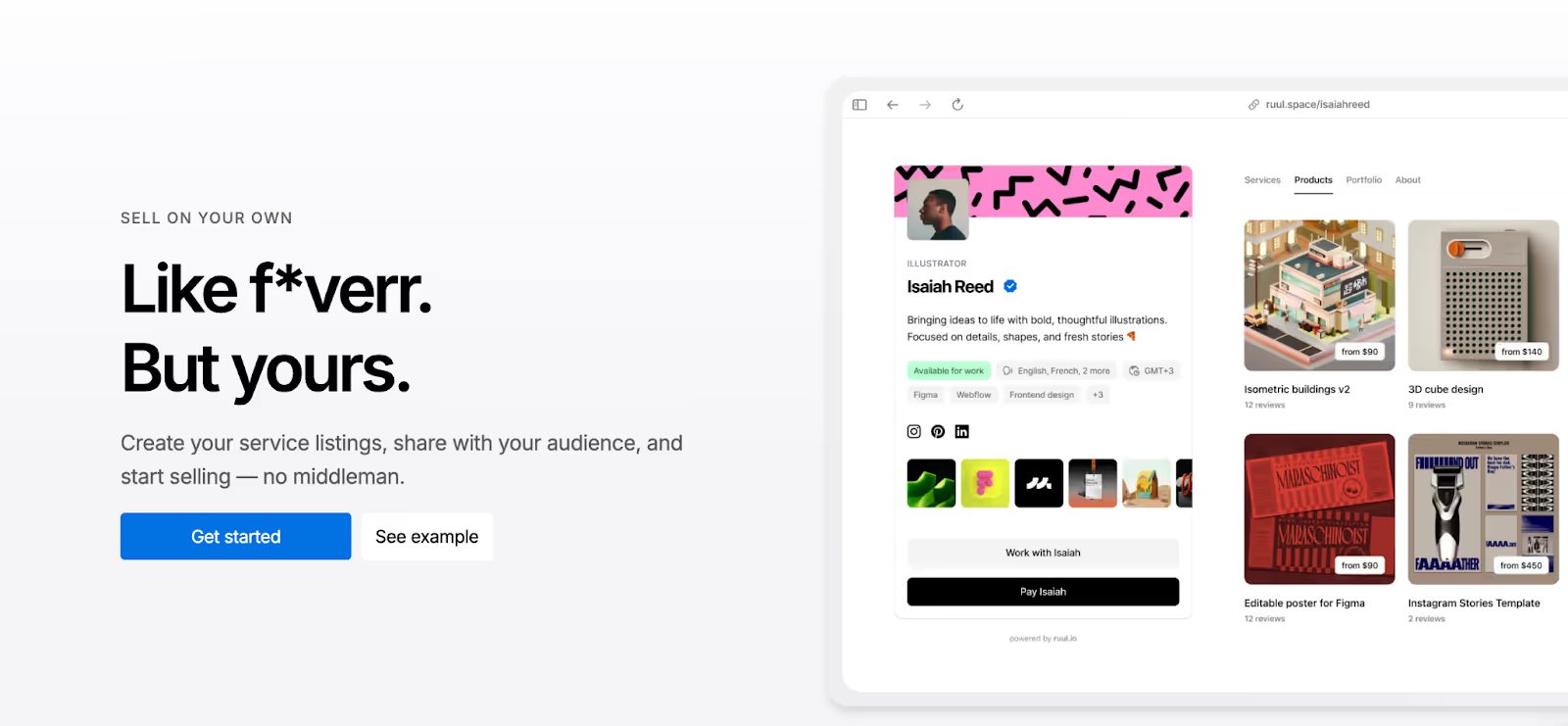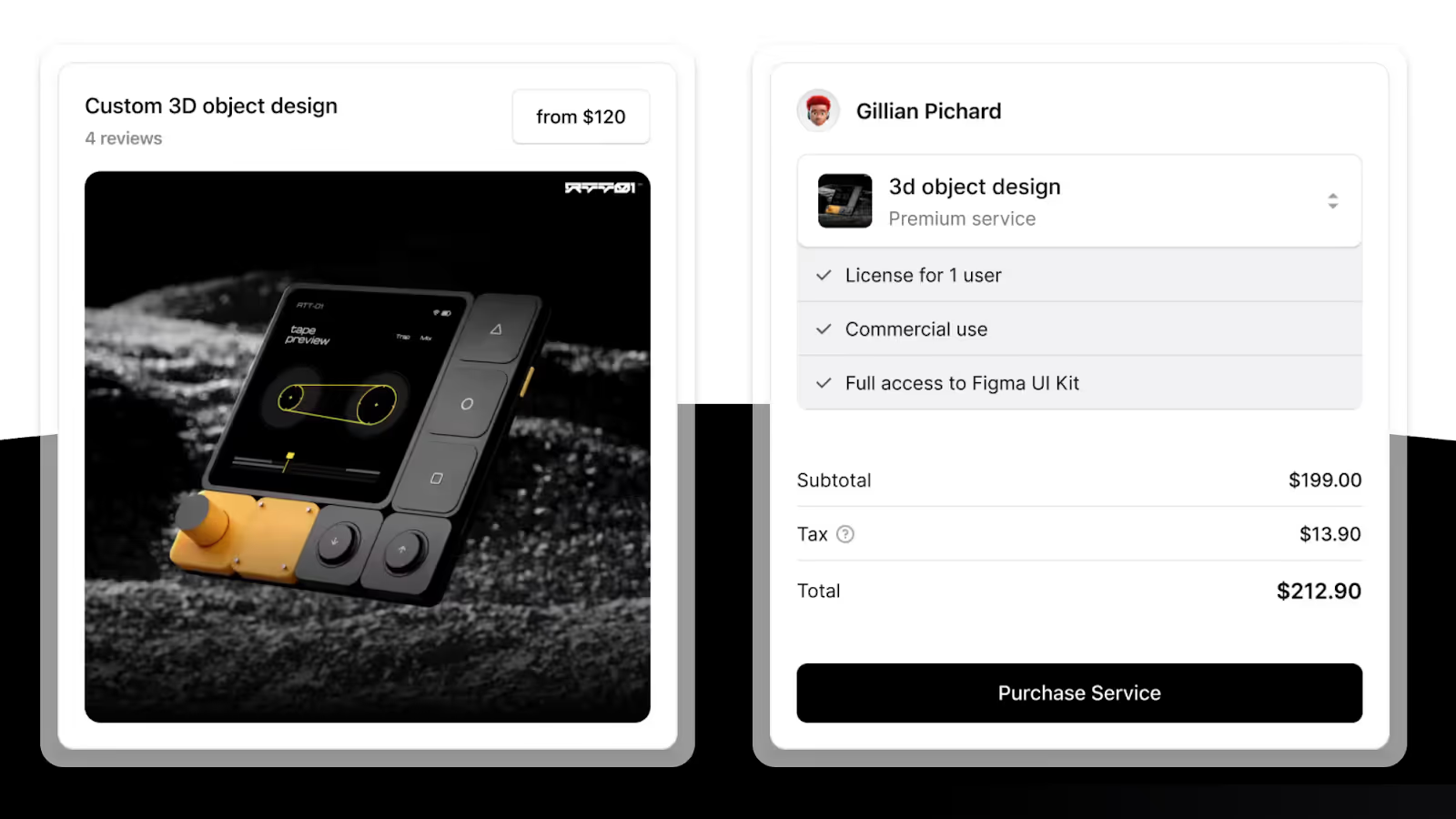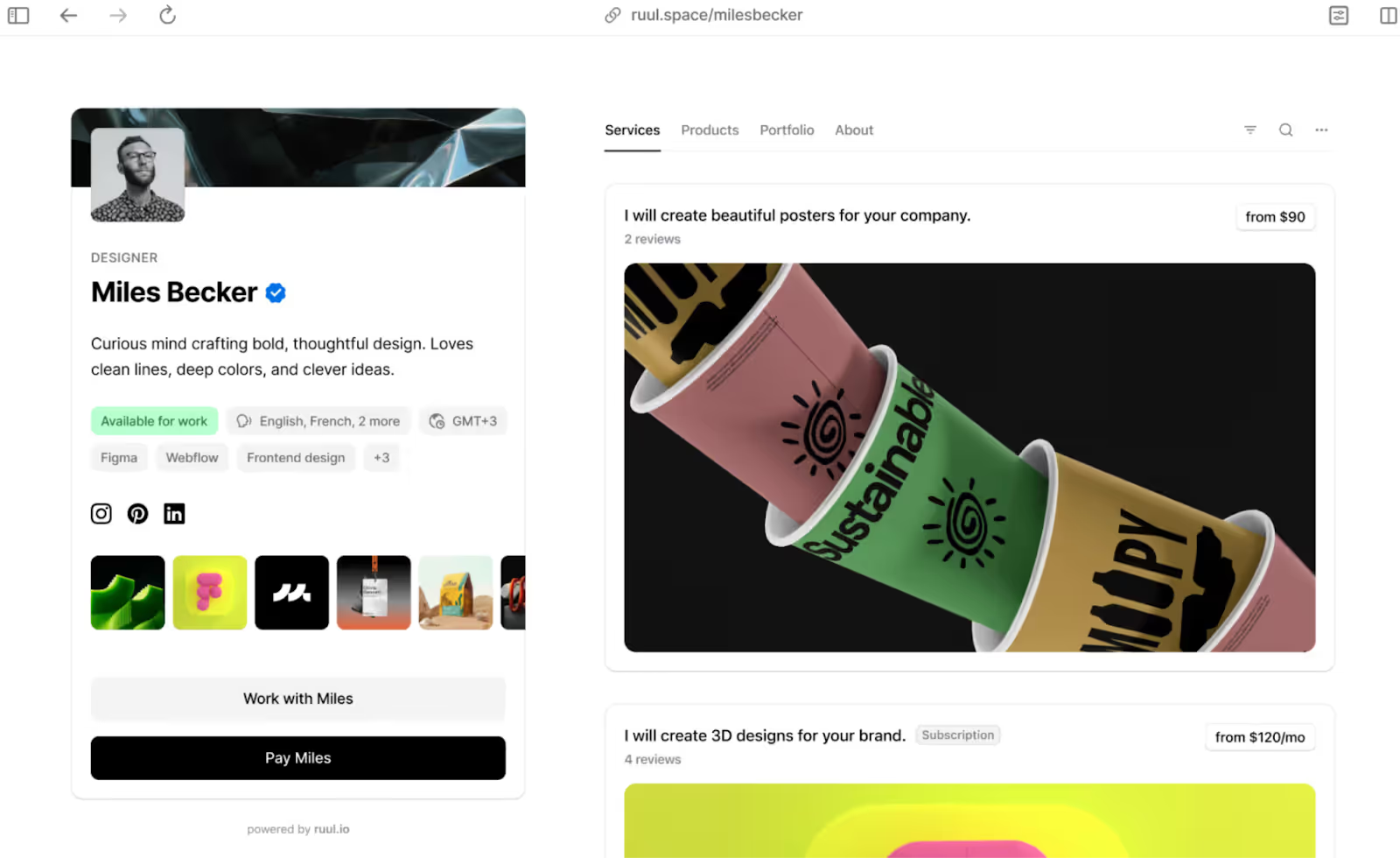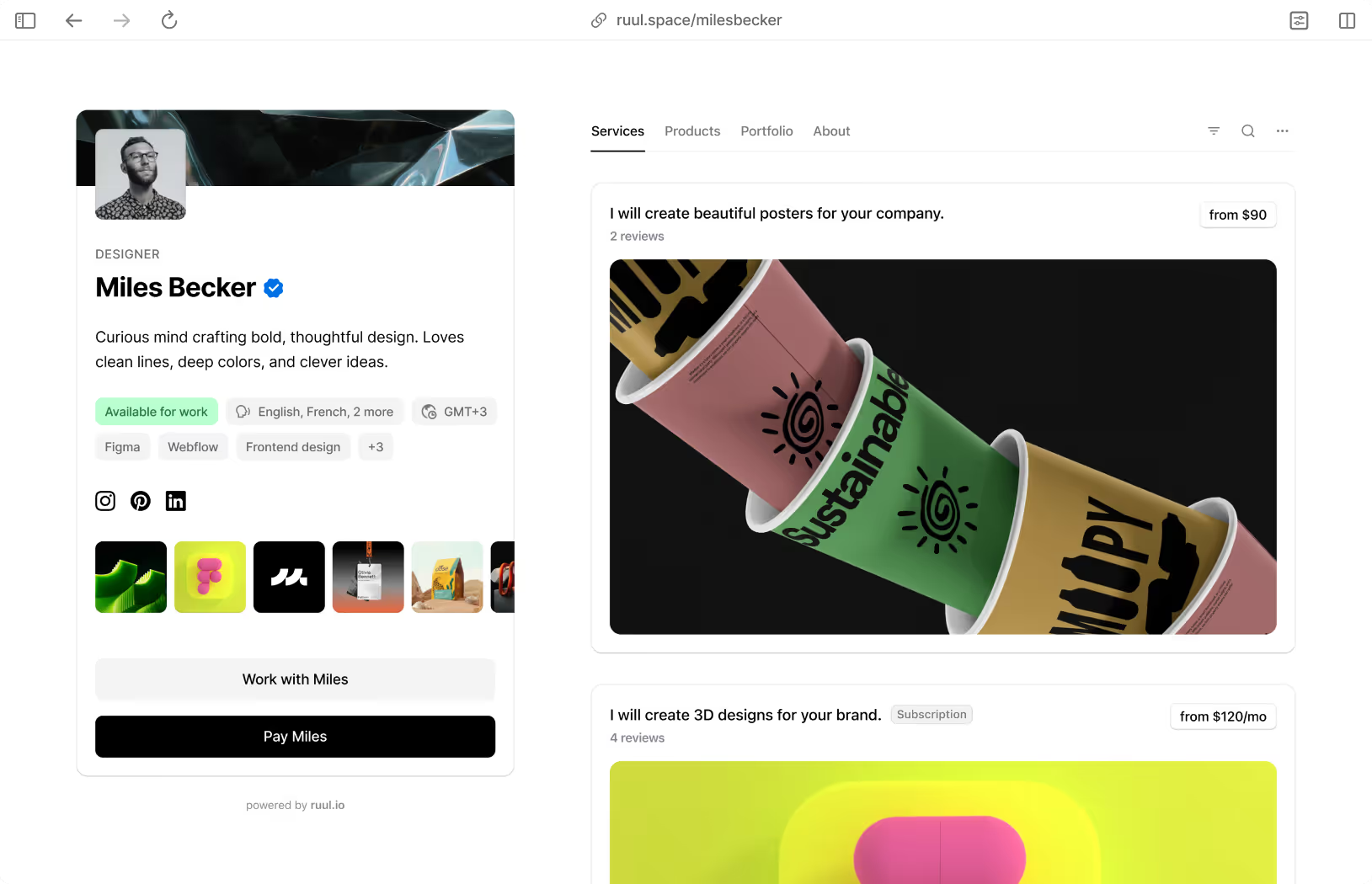Clients choose or scroll within seconds. Talent alone can’t hold them. Package, price, and pitch your skill like a product and trigger a quick yes.
This guide hands you rapid-fire tactics: crystal-clear offers, value-driven pricing, proof that melts doubt. Deploy them to leap past competitors, lock in projects faster, and lift your freelance income.
Ready to switch on? Let’s roll.
Why selling matters as much as your skills
Freelancing is a game of hunting for clients. Maybe the real edge isn’t just skill, it’s knowing how to sell it.
The myth of “good work sells itself”
That old saying, "Good work sells itself," might work if you’re Nike or Apple. But for freelancers? It’s a myth.
Let’s be real: If you don’t show up and put your work in front of people, no one will ever know how good it is. You can’t sell something you haven’t offered.
In my experience, I’ve seen this again and again:
People with average skills but sharp marketing instincts get booked solid, while the truly talented wait for recognition that never comes.
That’s why we created Ruul Space. It supports independents to showcase their services with the details that convert. No fluff. We put just what’s needed to sell freelance services once a potential clients see the profile.
And the pay button with automatic invoice is the cherry on top.

Good work can bring more clients in time, as you will have reviews to build trust. Potential clients can also read the reviews on your service or product page on Space.
Give it a try. It’s free until you get a “yes”. Then, we charge only 5% commission fee for the invoice and payment.
Freelancing = 50% skill, 50% sales mindset
A sales mindset means this: You don’t talk about tasks. You talk about outcomes. You don’t say, “I design logos.” You say, “I design logos that help your brand look credible and memorable.”
People don’t buy services. They buy solutions to their problems. And the peace of mind that comes with trusting the right person.
That’s why showing value beats shouting rates.
Instead of “$300 for this website,” say:
“This homepage helped X client double their bookings in 2 weeks.”
Back it up with:
- Client testimonials
- A clear, repeatable process
- Samples with before/after
- Communication that says: “You’re in good hands.”
The best freelancers don’t beg to be hired. They make the client feel lucky to have found them.
Step 1: Define what you’re really selling
Identify your niche and ideal client
Clients don’t hire generalists. They hire obvious fits. If you just say “I’m a designer,” it triggers questions instead of answers.
“What kind of designer? Can they handle this project?”
Now say:
“I design landing pages that convert for wellness brands.” Suddenly, you're memorable.
Afraid of losing clients? You won’t. Picking a niche doesn’t limit you. It positions you.
A pet brand won’t even see you if your portfolio is full of automotive websites. But if they see even one pet project? You’re in the game.
Plus, your style is part of your niche.
Whether it’s clean, modern, academic, or playful, owning your tone makes you relatable.
People don’t say:
“I know a designer who does everything.”
They say:
“I know someone perfect for that.”
Craft your unique value proposition (UVP)
If clients can’t quickly grasp how you help them, you’ll get overlooked. That’s where a clear UVP saves the day.
What’s a UVP, really?
It’s one sentence that answers:
“I help [audience] solve [problem] by doing [your unique method].”
Simple. Direct. Memorable.
Clients aren’t comparing you with amateurs. They’re choosing between people who all seem qualified. Your UVP gives them a reason to choose you.
Ask yourself:
What results do I deliver?
How is my process different?
What makes clients say, “You’re the one”?
Build it in 3 quick steps:
1. What do I do?
Instead of: "Instagram manager"
Try: “I create content strategies that grow Instagram visibility for wellness brands.”
2. Who do I do it for?
Define your ideal audience: startups, coaches, non-profits, SaaS?
3. Why me?
Highlight your edge. Speed? Visual taste? Industry experience?
Real-World UVPs:
“I simplify tech topics to help B2B brands educate their audience.”
“I craft social identities for entrepreneurs in crowded niches.”
“I design fast, scalable UIs for pre-seed startups.”
Step 2: Turn your service into a product
Because custom quotes and endless back-and-forths are killing your time.
Freelancers lose hours and money by reinventing the wheel for every client. Productizing your service solves that. It creates structure, sets clear expectations, and makes saying yes easier for your clients.
Name It. Package It. Sell It.
Let’s say you're a designer. Sure, you offer things like:
- Logo design
- Web design
- Brand identity
- Packaging
- Poster or font design
But right now, they’re just loose skills. You need to turn them into products with names, outcomes, and boundaries.
See this sample profile from Ruul Space, the personal storefront of independents with a payment button.

This profile works well because Gillian gives a solid definition of his service and has a sample work picture just under the definition. Also, on the side, the buyer can see what’s included in the prices. Clean.
Instead of “Logo Design,” offer:
→ Launch-Ready Logo Kit (with a mini brand guide and two mockups)
→ Brand Sprint Package (for startups needing a quick turnaround)
→ Premium Identity System (for brands that want polish + scalability)
These aren’t just services. They’re solutions with edges. That’s what people buy.
Ditch Hourly. Think in Packages.
Hourly pricing punishes efficiency.
Let’s be real: the better you get at your craft, the faster you work. Should that mean you earn less?
Let’s flip it.
- You design a sales page in 3 hours.
- Your client makes $7,000 from it.
- If you charge by the hour, you make $300.
If you price based on value and outcome, you might charge $1,500, and it still feels like a win for them.
Instead of selling your time, sell the transformation. Ask:
“What is this worth to the client?”
“What would happen if they didn’t hire me?”
You’re not a pair of hands. You’re a multiplier.
Create three tiers (strategically)
People don’t like to be cornered into one price. That’s why three packages work:
- Basic → for low-risk clients who want a taste
- Standard → your sweet spot
- Premium → high-touch, high-margin
But don’t just throw random features into each. Be intentional:
- Basic = limited scope, slower delivery, 1 revision
- Standard = deeper involvement, 2–3 revisions, faster turnaround
- Premium = full attention, VIP timeline, extra consulting
This way, you’re not just attracting more clients. You’re upselling without pressure. And yes, Premium gets top priority. Always.
Set boundaries like a Pro
Make deliverables and timelines crystal clear:
- What’s included
- What’s not
- How many revisions
- How fast they’ll get it
And stick to it. When clients know the rules, they’re more likely to respect your time and pay for upgrades when they want more.
Step 3: Build trust with a solid online presence
Because even the best services don’t sell if no one can find or trust you.
Clients Google you. They click on your links. They skim your work in 30 seconds or less. That’s why a strong online presence is a leverage.
You don’t need to be everywhere. You just need to show up where it matters, with the right message and the right proof.
Build a simple, effective portfolio
A good portfolio doesn’t just show your work, it sells it.
See this:

Instead of listing everything you’ve ever done, curate 4-5 pieces that clearly show what you do, how you do it, and what kind of results you’ve helped clients achieve. Start strong. Lead with your best. Don’t make them dig.
Think of it as your storefront, not your archive.
Static PDFs or old-school slides? They still work for some industries, but they feel clunky for fast-moving, digital-first clients. If you're in design, writing, marketing, or tech, you're better off with something interactive and easy to update.
And make sure you're building your portfolio on the right platform. If you're a writer, you need to know that Behance and Dribbble are just for designers. Instead, head over to Ruul, which allows sales for all freelance services.
- Design-heavy work? → Behance, Dribbble
- Freelancers offering services? → Contra, Ruul Space
- General portfolios or writers? → Personal sites, Notion, or even Carrd
- Developers? → GitHub + a clean landing page with context
The key is removing friction. Clients should be able to view your work, understand what you offer, and take the next step. All in one place.
If you’ve productized your services (see Step 2), Ruul Space lets you embed service packages directly into your profile. So your portfolio becomes a shop. No discovery call needed unless you want one.
Add testimonials, reviews, and case studies
Testimonials and case studies build instant trust. They’re conversion boosters. And they make your online presence way more persuasive.
But let’s be clear: only real testimonials from real clients.
Today’s clients, especially younger ones, can sniff out fake reviews and bots in two seconds. Don’t risk it. Fake engagement gets you flagged, shadowbanned, or ignored.
How to actually get testimonials?
They rarely fall from the sky. You have to ask, but you don’t have to beg.
After you complete a project, send a short message like:
“Hey [Name], it was great working with you! If you’re happy with the results, would you be open to writing 2–3 sentences about your experience working together? I’d love to include it in my portfolio.”
If you want to incentivize it, you can offer a small promotion or discount on future work. But it’s not required. Keep it genuine.
And remember: a helpful testimonial doesn’t just say “They were great!” It mentions:
- What problem they had
- What you did
- What changed afterward
That’s what builds trust.
So, where to use testimonials?
Everywhere. But strategically:
- Add them to your portfolio (next to relevant projects)
- Include them on your website or landing pages
- Share short quotes on LinkedIn as social proof
- Sprinkle them into case studies to add credibility
Case studies: Go beyond "I did this"
Case studies take more effort. But they’re gold when done right. Why? Because they tell a story: the problem, the process, the outcome.
Here’s the tricky part: clients often don’t give you performance metrics. And even when they do, multiple people are involved. So, who gets credit?
Don’t let that stop you.
Focus on what you directly influenced. Ask your client:
- “Did anything change after we launched the project?”
- “What feedback did you get?”
- “Have you seen results in [sales/engagement/etc] since then?”
Then, turn that into a narrative. Add visuals. Add screenshots. Show numbers if you have them. A strong case study describes the work and proves it had an impact.
If you’re just starting out…
No clients yet? No problem. Offer your service at a discount to 2–3 people in exchange for honest feedback and a testimonial. Use that to kickstart your proof and build momentum.
Step 4: Find the right channels to promote yourself
Marketing is part of the job. That doesn’t mean dancing on every social platform or chasing every trend. It means picking the right channels, where your work fits, where your clients look, and where you won’t burn out trying to be everywhere.
Let’s look at your options and how to choose them.
Freelance platforms (Ruul, Upwork, Fiverr, etc.)
Think of these as freelance marketplaces. Clients are already searching; your job is to show up.
Some are beginner-friendly. Others are curated, invite-only, or niche-specific. Here’s how they break down:
General freelance platforms
- Ruul: great for freelancers selling digital services, offering packages, and getting paid globally
- Upwork: bid-based, wide range of work
- Fiverr: gig-based, fast-paced, pricing flexibility
- Freelancer.com: similar to Upwork, but lower visibility
These platforms are competitive, especially at first. Landing that first client takes effort. But once you do, momentum builds.
Ruul, for example, lets you list productized services, handle payments, send invoices, and stay compliant with tax requirements—all under one roof with a simple 5% transaction fee. Especially helpful if you want to keep admin work minimal.
Creative & design-focused freelance platforms
- Behance and Dribbble: ideal for showcasing visual work
- Contra: portfolio + service store in one, especially for designers and developers
Premium & curated freelance platforms
- Toptal: rigorous screening, but higher pay
- Contently: a curated marketplace for writers
- We Work Remotely: job board model, great for devs and marketers
Before signing up, check:
- Does the platform match your niche?
- What are their fees and membership terms?
- Can you list fixed-price services, or is it all proposal-based?
Pro tip: Go to Fiverr or Upwork and search for your service (“logo design,” “email copy,” “Notion expert”). Look at the top sellers, what do their gigs include? What kind of reviews do they get? This gives you a sense of real demand and positioning.
Social media
- LinkedIn is gold for B2B freelancers to share client wins, processes, before/afters, and testimonials.
- Instagram / Threads work well for visual storytelling and lifestyle-driven work.
- Twitter/X is useful for thought leadership in tech, startups, and writing.
- YouTube or TikTok (if you’re confident on camera) can build powerful trust at scale.
Don’t start with all of them. Pick one or two that match your natural content style.
Cold outreach (email, DM)
Yes, cold outreach still works. But only if you treat it like a conversation, not a broadcast.
People’s communication habits have completely shifted. We're listening to voice notes at 2x speed, skipping intros on YouTube, and tapping “Mark as Read” without even opening emails.
That tells you everything about attention today: if it’s long and irrelevant, it’s getting skipped.
So if you’re going to cold email, DM, or message someone, make it count.
Send short, personalized messages.
Our inboxes and DMs are already overflowing. If you want someone to actually read (and reply to) your message, you need:
- A specific reason for reaching out
- A short, clear message
- A signal that you’ve done your homework
Don’t message strangers at random.
Instead, find people or businesses you actually want to work with. Study what they do. Follow them. Engage with their content. Then, reach out.
Here’s the difference:
❌ Don’t say:
“Hey, I’m a freelancer. Let me know if you need help.”
That’s vague, forgettable, and looks like a copy-paste.
✅ Instead, say:
“Hi [Name], I saw your article on [Topic] and noticed it hasn’t been updated in a while. Would you be open to a quick refresh or content revamp?”
Want to go one step further? Mention the actual headline or offer a tiny idea:
“For example, the section on SEO tools could use some 2024 updates. I’d love to help with that.”
The key here is relevance and timing. You’re not just introducing yourself, you’re solving a tiny problem before they even ask.
Warm up before you reach out:
Your success rate goes up when they’ve seen your name before.
So, before sending that message:
- Follow them
- Comment meaningfully on a few posts (not just a thumbs-up emoji)
- Share or engage with their work
This builds familiarity and trust and makes your pitch less “cold.”
Inbound marketing (content, SEO, networking)
While cold outreach is proactive, inbound marketing works the other way:
You build things once. Then they attract clients over time.
This includes:
- Content marketing: blog posts, templates, guides, case studies
- SEO: optimizing your site or profile to get found in Google searches
- Networking: showing up on LinkedIn, in communities, events, and group chats where your people hang out
These strategies are slower to start. But they scale.
You might cold email someone today, and six months later, they’ll google your name… and find your content instead. That’s when inbound pays off.
Finally, think of cold outreach as manual marketing. Until you have a marketing team… this is on you.
Yes, one day you might hire someone to handle leads, prospecting, or even email campaigns. But until then, it’s your job to put yourself in front of the right people
Step 5: Master the sales conversation
Sales meetings aren’t just about landing a project. They’re where expectations are set, trust is built, and long-term client relationships begin.
And honestly? It’s where many freelancers trip up. Either by saying yes too quickly, rushing the process, or getting talked into prices that don’t make sense.
Ask smart questions, don’t pitch blindly
The fastest way to a chaotic project is this: starting without clarity.
If a client’s brief is vague, incomplete, or full of assumptions, it’s your job to slow things down and ask the right questions. Otherwise, you're setting yourself up for:
- “Wait, I thought that was included.”
- “This isn't what I expected.”
- “Can we redo the whole thing?”
- Or the dreaded: “Someone else can do it cheaper.”
These situations are frustrating. They can turn a promising opportunity into a reputation risk.
So, how do you avoid it? Ask questions that uncover real needs, not just surface tasks.
Examples:
- “What problem are you trying to solve with this project?”
- “What does success look like from your perspective?”
- “Have you worked with freelancers before? What went well, and what didn’t?”
- “Is there anyone else involved in approvals?”
Once you have clarity, clearly outline:
- What’s included
- What’s not
- Timeline
- Revision rounds
- Expected outcomes
This alone can save you weeks of miscommunication.
Handle pricing discussions with confidence
Pricing is positioning. If you sound unsure, clients will question your value.
Yes, some clients will say:
“That’s a bit high for us.”
“We’ve seen cheaper.”
“Our budget is limited.”
And that’s okay.
The key is to stay grounded. Offer flexibility within boundaries:
“With that budget, here’s what I can do: I can deliver X instead of Y, while still maintaining quality.”
You’re not downgrading your value. You’re right-sizing the scope.
Pro tip: Package your services ahead of time. When you present three clear tiers (Basic, Standard, Premium), it shifts the conversation from “how cheap can we go?” to “which value tier fits best?”
Send clear, value-focused proposals
Don’t sell a logo. Sell what the logo does.
Don’t say: “I’ll design a modern logo with 2 revisions.”
Instead say:
“Your new logo will position your brand as more premium, and give you consistency across platforms. Which helps improve brand recall and trust.”
You’re not just offering a file. You’re offering an outcome. When clients understand what they gain, price becomes a secondary conversation.
Step 6: Keep the client and multiply the work
Winning a client is great. Keeping that client and turning one job into many is where real growth happens.
Most freelancers get stuck in the cycle of constantly looking for new work. But when you focus on building long-term relationships, everything changes. You get stability, better income, and better clients. Here's how to make that shift:
Offer upsells and add-ons
You don’t need to be a slick salesperson to upsell. You just need to spot what else your client might benefit from and bring it up at the right time.
Think like this: “If they already trust me to do X, would they also benefit from Y?”
For example:
- A logo designer could offer a brand style guide or social media templates.
- A copywriter could offer SEO optimization, email sequences, or blog post repurposing.
- A web developer could offer monthly site maintenance or analytics reports.
These aren’t “tricks”, they’re real enhancements that help your client succeed.
Position it like this:
“Many clients in your space have seen even better results by adding [X]. It’s a smaller add-on, but it helps tie everything together.”
Bonus tip: Keep add-ons at a lower price point to make them easy yes-es. Small additions can turn into big loyalty over time.
Deliver so well that they don’t want to go elsewhere
If you’re thinking about recurring work, the first project is your audition. Blow them away.
Here’s what that looks like in practice:
1. Deliver pro-grade work (especially the first time)
This is your moment to stand out. Especially if the client has had poor experiences with freelancers before, show them it can be different.
2. Be lightning-fast and clear in communication
You don’t need to reply instantly, but don’t leave people hanging. Keep them in the loop, respond to feedback with clarity, and anticipate their questions before they ask.
3. Set expectations like a pro
Define the scope, timeline, revisions, and hand-off process clearly.
Say: “Here’s what’s included. Here’s what’s not. Here’s when you’ll hear from me next.”
Uncertainty kills trust. Clarity builds it.
4. Offer a small, thoughtful extra
This doesn’t mean giving away hours of work. It could be:
- An extra version in a different format
- A Loom video walking through your design
- A short doc with tips for using what you delivered
5. Provide post-delivery support (Optional but powerful)
After the hand-off, check in. Offer a 3–5 day window for light support or clarification.
Say:
“If anything unexpected comes up, feel free to reach out. I’ll be around this week if you need tweaks.”
That simple message makes people feel safe working with you again.
If you want recurring clients, act like a long-term partner
Don't wait for clients to suggest more work. Be the one who says:
“Next quarter, if you’re planning another campaign, I’d love to be involved.” or “If you'd like ongoing support, I offer monthly packages tailored to what you're already doing.”
Even if your service seems one-off (like designing a logo), there are often natural follow-ups:
- Brand extensions
- Ongoing assets
- Seasonal updates
- Retainers for advice or tweaks
Think one step ahead. So your client doesn’t need to look elsewhere.
How Ruul simplifies your freelance sales
Forget juggling invoices, taxes, payments, and compliance across borders. At Ruul, we take that burden off your hands. So you can focus on doing your best work.
1. Sell packages & subscriptions in one place
- Create service packages (e.g., Basic, Standard, Premium) effortlessly.
- Launch recurring services like coaching or monthly support with just a few clicks.
- Present everything via a clean storefront that turns browsers into buyers instantly.
2. We handle the legal work
- We act as your Merchant of Record, legally selling your services in 190 countries.
- We automatically calculate and remit VAT, GST, and global sales taxes, saving you from paperwork and audits.
3. Accept payments in 140 currencies + crypto
- Clients can pay in their preferred currency, fast and hassle-free.
- Want crypto? We support USDC—payouts happen in seconds.
4. Fast, transparent payouts
- No monthly fees. Just a transparent 5% commission per sale.
- Get your money within 24 hours via bank or crypto wallets.
5. Why freelancers love it?
- We onboard clients and manage all billing and tax compliance.
- We provide B2B invoices that simplify client accounting.
- We support 140K+ freelancers globally—rated 4.8 on Trustpilot.
In short,
Ruul isn’t just a checkout plugin. It’s your legally compliant, global freelancing backbone. We manage the sales, taxes, compliance, and payouts. You do the creative work.
Ready to make selling easy? Set up your first service package now, activate your storefront, and relax. Ruul handles the rest.
FAQ
1. How do you sell your freelance services?
Define your niche, package your offers clearly, focus on outcomes, build trust, and promote where your ideal clients hang out.
2. How to market your freelance services?
Choose platforms your clients use, showcase results, share testimonials, engage meaningfully, and use clear, value-driven messaging to attract attention.
3. How much should I charge for freelance services?
Charge based on the value and results you deliver, not hours. Offer tiered packages to fit different client budgets.










